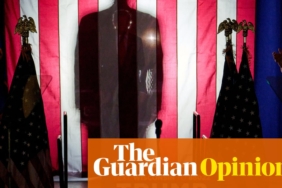İçindekiler
Bu içerik, 2024 yılında Azerbaycan’da düzenlenen BM iklim zirvesine odaklanmaktadır. Zirve, özellikle 2015 Paris anlaşması gereği iklim finansmanı için yeni kolektif hedef (NCQG) üzerine odaklanmaktadır. Zengin ülkeler, gelişmekte olan ülkelerin sera gazı emisyonlarını azaltmalarına ve iklim krizinin etkileriyle başa çıkmalarına yardımcı olmak için iklim finansmanı sağlamakla yükümlüdür. Mevcut finans hedefi, yoksul ülkelere yılda 100 milyar dolar sağlama hedefi genellikle yetersiz olduğu kabul edilmekte olup, zengin ülkeler çoğunlukla bu rakamın birkaç kat daha yüksek olması gerektiğini kabul etmektedir. Ayrıntılar için içeriği inceleyebilirsiniz.
Kaynak: www.theguardian.com
This year’s UN climate summit, being held in Azerbaijan, is focused on finance, and specifically the new collective quantified goal (NCQG) for climate finance, required under the 2015 Paris agreement. Rich countries are bound under the agreement to provide climate finance to help developing nations cut their greenhouse gas emissions and cope with the impacts of the climate crisis. The current finance goal, of providing $100bn a year to poor countries, is widely acknowledged to be inadequate, and most rich countries agree the figure needs to be several times higher.
The NCQG
Poor countries are asking for finance of about $1tn a year by 2035, based on widely accepted estimates of their needs. Rich countries are likely to agree to a considerably smaller sum, perhaps about half that amount, to be paid from their exchequers and through multilateral institutions such as the World Bank.
The gap could be met from a variety of means, including new taxes on fossil fuels or the diversion of existing subsidies to cleaner ends. These “innovative sources of finance” will not be fully articulated or agreed at Cop29 and will need further work.
Rich countries are demanding that the contributor base be expanded. Currently, only countries defined as developed under the 1992 UN framework convention on climate change contribute to official climate finance. But many countries’ economies – and greenhouse gas emissions – have expanded considerably in the last 30 years, including China, which is now the world’s second biggest economy, behind the US, and the biggest emitter by a long way. Petrostates such as Saudi Arabia, Qatar and the United Arab Emirates, with their vast oil wealth, are also classed as developing economies.
Many countries are resistant to expanding the contributor base, but the EU’s position is that it will not accept a climate finance goal higher than the current $100bn unless more contributors are included. There could be a compromise by which some developing countries contribute on a voluntary basis or are allowed to be both contributors and recipients of climate aid.
If countries can overcome their differences, what could emerge from the fortnight of talks is a “layered” NCQG that includes an overall goal measured in trillions, plus a public finance goal measured in hundreds of billions, and a narrative committing countries to work on filling the gaps, including through innovative sources of finance (see below).
Loss and damage
One key strand of climate finance is the vexed issue of “loss and damage”, the term that describes the most extreme damages of the climate crisis, so severe that no amount of adaptation could have prevented them. Examples include the devastating floods in Pakistan two years ago, or hurricanes that have wiped out towns and villages, and large chunks of afflicted countries’ infrastructure and economies.
Loss and damage funds are intended for the rescue and rehabilitation of countries and communities afflicted by these extreme events. For years, developing countries’ pleas for loss and damage funding went unheard, but last year there was a breakthrough at the Cop28 summit when plans for a loss and damage fund were finalised. The fund is to be set up under the aegis of the World Bank, despite some misgivings among developing countries over the bureaucracy this involves.
The fund still needs to be filled with cash from donors, and it is still unclear when it will start to disburse money, so countries will be hoping for progress towards “operationalising” it at Cop29.
NDCs
Rapid and deep cuts in greenhouse gas emissions will be crucial if the world is to stave off the worst ravages of climate breakdown and have any chance of staying within the vital threshold of 1.5C of heating above preindustrial levels. Cuts need to reach net zero emissions by 2050, but current national plans by governments – called nationally determined contributions, or NDCs, in the UN jargon – are nowhere near that.
Cop29 is mainly about climate finance but the need for new NDCs cannot be ignored. Governments are supposed to submit their updated plans next February, well ahead of the Cop30 conference in Brazil next November, where they will be assessed.
The election of Donald Trump in the US is likely to cast a pall over efforts to get countries to submit stringent new NDCs. Many recalcitrant countries are likely to use his climate denial as cover for their own inaction. Cop29 will be judged a success if the hosts can persuade countries to agree to submit new NDCs next year despite that.
Transition away from fossil fuels
One of the biggest achievements of the Cop28 conference in Dubai last year was a commitment to “transition away from fossil fuels”, contained in paragraph 28 of the Cop decision and a core part of the “UAE consensus” that was the main outcome of that meeting.
Since then, however, some countries, including Saudi Arabia and other members of its loose collection of allies, known as the “like-minded developing countries” grouping, have tried to unpick the commitment. Behind closed doors during the negotiations leading up to Cop29, they have variously argued that the commitment is optional rather than binding and that countries were strong-armed into it without being allowed to consider it properly.
after newsletter promotion
Azerbaijan is also a major fossil fuel producer, though it has a target of generating a third of its energy from green sources by 2030. As host, it will be responsible for ensuring there is no unpicking or backsliding from previous commitments.
Article 6
Carbon trading has been a vexed issue at climate talks since their earliest days, and article 6 of the Paris agreement has been like a serial killer in a horror film, constantly coming back from the seeming dead.
Article 6 was supposed to have been solved in the immediate aftermath of the Paris summit in 2015, but by 2019 it was still an outstanding issue, left over when the rest of the “Paris rulebook” was finalised. It was discussed again at Cop26, where it was again supposed to be finalised, only to re-emerge at Cop27 and Cop28. Some delegates are saying it will finally be sorted out this year; others heave a weary sigh.
At root, the problem is there are fundamental misgivings among many countries over whether and how a carbon offsetting system can work. Widespread examples of fraud and misdealing have plagued the carbon markets for two decades, some of them recently uncovered by the Guardian. The concept of paying countries to keep their forests standing is an attractive one, because the fundamental problem is that without such payments people can make more money from chopping down trees in their territories and converting the land to plantation or ranching.
Awarding landowners carbon credits for their forests raises problems of moral hazard – were the forests really at risk from loggers, or have the owners confected or exaggerated the risk to gain cash? Governments and private sector companies want to create a market for credits that have integrity, accountability, transparency and that achieve the aim of contributing to net zero targets, but the steps towards doing so have been painfully slow.
Carbon trading has assumed a new importance this year as it could provide a source of cash for the NCQG. But this is unlikely to amount to much more than a few tens of billions, a sliver of the trillions needed. It is possible that the Azerbaijani presidency will achieve what no other Cop host has done and resolve the conflicts over article 6, but it will not be a high priority.
Innovative forms of finance
Poor countries require at least $1tn a year in finance to help them cut greenhouse gas emissions, shift to a low-carbon economy and adapt to the impacts of extreme weather. Developed countries are currently willing to ensure about half of that is provided from public sources. That leaves a large gap, which countries are hoping to fill with other sources of cash, known as innovative forms of finance.
These can take the form of levies on high-carbon activities, from flying private jets to oil and gas extraction, or taxes on wealth, the idea of which is gaining traction as global inequality grows rapidly. But all of these innovative forms of finance have winners and losers, and some are likely to be difficult to implement.
No firm decisions will be made on these issues at Cop29, but countries should agree to carry on discussing them and send a clear signal that these options are on the table.





Yorumlar kapalı.